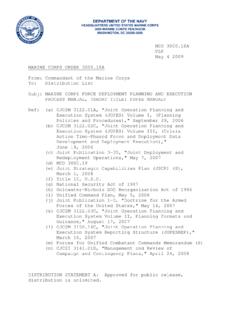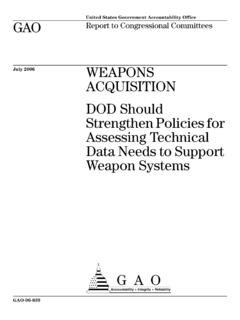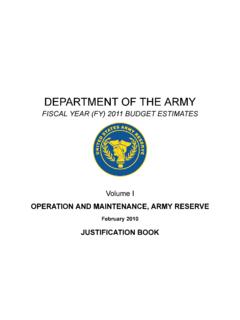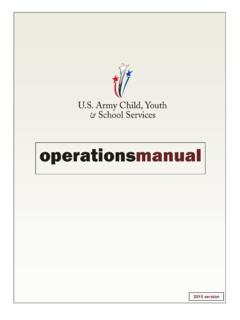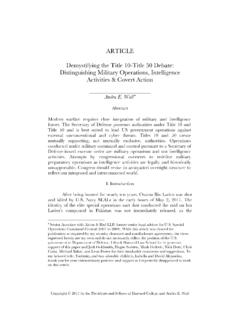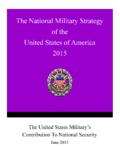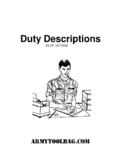Transcription of MEASURES OF EFFECTIVENESS IN STABILITY …
1 MEASURES OF EFFECTIVENESS IN STABILITY operations Foreword Accurate assessment and usable MEASURES of EFFECTIVENESS are essential to success in STABILITY operations . Improving the ability of a host nation (HN) governmentto deliver services expected by its populace is necessary to enhance the stabilityof a society, maintain the legitimacy of its HN government, and to allow the HN government to out administer local insurgency groups. Correctly identifying what the local population expects from its HN government is fundamental todeveloping plans and operations that will build HN government capacity, social STABILITY , and undermine threats to the HN government and civilian populace like social instability or violent insurgency. The daunting tasks of identifying and crafting responses to the causes and consequences of weak or failed states requireorganized and methodical programs with accurate, measureable and verifiable results.
2 In recent and current operations , the military and its interagencypartners have been required to manage substantially increased levels of assistanceto assist and ensure success of legitimate governments. In this complexenvironment, companies, battalions, brigade combat teams, divisions, and corpswill perform assessments and collect data. Assessment framework allows for a common operational picture shared by military and government departmentsand agencies in the area of operations (AO). Knowing the fundamentals andpurpose of assessments is key to providing quality products to assist campaignplanning and support decision making. Listed below are some key points for success: Know the AO, the people, and their customs. Determine the perceptions of the local populace and understand how toinfluence those perceptions. Know the history, government, and economic challenges. Know the causes of instability. Know or develop the plan to correct these causes and prevent their return.
3 Know how to measure EFFECTIVENESS , analyze results, and adjust plans if necessary. i Know how to collect and organize data. Understanding by military leaders is not enough everyone needs tounderstand. Military leaders need to use a framework, a system, processes,and structures to enact this understanding. iii MEASURES OF EFFECTIVENESS IN STABILITY operations Assessments and MEASURES of EFFECTIVENESS in STABILITY operations Table of Contents Chapter 1. Assessment in STABILITY operations 1 Chapter 2. Assessment support to Planning 13 Chapter 3. Organize and Prepare for Assessments 19 Chapter 4. Execute Assessments 23 Chapter 5. Best Practices and Insights 31 Appendix A. Tactical Conflict Assessment PlanningFramework Tool Kit 37 Appendix B. Provincial Reconstruction Team Maturity Model 51 Appendix C. Internet Resources and Research Techniques 61 Appendix D. Key Terms 67 Appendix E. References 71 Director Branch Chief/Managing Editor CALL Analyist Production Coordinator Editor Graphic Artist Distribution Manager Colonel Thomas Joseph Murphy Larry K.
4 Hollars Kevin B. Makel Kristine Bell Michael Brooks Eric Eck Candice Miller Center For Army Lessons Learned The Secretary of the Army has determined that the publication of this periodical is necessary in the transaction of the public business as required by law of theDepartment. Unless otherwise stated, whenever the masculine or feminine gender is used, bothare intended. Note: Any publications (other than CALL publications) referenced in this product, such as ARs, FMs, and TMs, must be obtained through your pinpoint distribution system. 1 MEASURES OF EFFECTIVENESS IN STABILITY operations Chapter 1 Assessment in STABILITY operations This is a political as well as a military war .. the ultimate goal is to regain theloyalty and cooperation of the people. It is abundantly clear that all political,military, economic, and security (police) programs must be integrated in order to attain any kind of success. General William C.
5 Westmoreland, Commander, Military Assistance Command, Vietnam (MACV), MACV Directive 525-4, 17 September 1965 The Necessity of Assessment Today s adversary is a dynamic, adaptive foe who operates within a complex interconnected operational environment (OE). In recent and current operations theUnited States ( ) and coalition partners combated global terrorism in a numberof regions. STABILITY operations are a key component of the national strategyto defeat terrorism. Within the government, the complex nature of STABILITY operations resulted in the increased level of cooperation between the Departmentof Defense (DOD) and other government agencies. The goals of STABILITY operations are stated in DOD Instruction (DODI) , 16 September 2009: The Department shall assist other government agencies,foreign governments and security forces, and internationalgovernmental organizations in planning and executing reconstruction and stabilization efforts, to include: (1) Disarming, demobilizing, and reintegrating former belligerentsinto civil society.
6 (2) Rehabilitating former belligerents and units into legitimatesecurity forces. (3) Strengthening governance and the rule of law. (4) Fostering economic STABILITY and development. The Purpose of Assessment in STABILITY operations The process of assessment and measuring EFFECTIVENESS of military operations , capacity building programs, and other actions is crucial in identifying andimplementing the necessary adjustments to meet intermediate and long term goalsin STABILITY operations . As time passes and operations , programs, actions, and activities become effective, local institutional and societal capacity will increase and the drivers of conflict and instability will be reduced, meeting the goal of passing the lead to local authorities (see Figure 1-1). 2 CENTER FOR ARMY LESSONS LEARNED Figure 1-1. Example of STABILITY operations assessment The fusion of traditional military operations and capacity building programs government agencies like the State Department and Agency for International Development are required to meet the challenges of restoring andenhancing STABILITY in troubled areas and regions.
7 Accurate and timely assessment of military operations and the actions of government departments andagencies are vital to the success of STABILITY operations . DoDI , 16 September 2009, states the following: STABILITY operations are a core military mission that theDOD shall be prepared to conduct with proficiency equivalent tocombat operations . The DOD shall be prepared to: (1) Conduct STABILITY operations activities throughout all phasesof conflict and across the range of military operations , including combat and noncombat environments. The magnitude of STABILITY operations missions may range from small-scale, short-duration tolarge-scale, long-duration. 3 MEASURES OF EFFECTIVENESS IN STABILITY operations (2) support STABILITY operations activities led by other departments or agencies (hereafter referred tocollectively as government agencies ), foreign governmentsand security forces, international governmental organizations, or when otherwise directed.
8 (3) Lead STABILITY operations activities to establish civil security andcivil control, restore essential services, repair and protect criticalinfrastructure, and deliver humanitarian assistance until such time as it is feasible to transition lead responsibility to other agencies, foreign governments and security forces, orinternational governmental organizations. In such circumstances, DOD will operate within government and, as appropriate,international structures for managing civil-military operations ,and will seek to enable the deployment and utilization of theappropriate civilian capabilities. Since most stabilization operations occur in less developed countries, there willalways be a long list of needs and wants like schools, roads, health care, etc. in anarea of operations (AO). Given the chronic shortage of government personnel and resources, effective STABILITY operations require an ability to identify and prioritize local sources ofinstability and STABILITY .
9 The focus is on the perceptions of the local populace, what those perceptions are,and how to positively influence those perceptions. STABILITY operations require prioritization based on progress in diminishing the sources of instability orbuilding on sources of STABILITY . For example, if government personnel believe access to information aboutWestern culture will undercut insurgent recruiting and provide a village with an Internet caf , but the village elders tell the personnel they want morewater the village is not being efficiently or effectively stabilized. By ignoring the village elders, government personnel undermine the legitimacy of thevillage elders within their own population, and undermine the elders ability to maintain some semblance of order, thereby contributing to the instability. Access to information about the rest of the world via the Internet caf may create a risingtide of expectations that cannot be met by the village elders or the host nationgovernment.
10 There may be disputes over access to the Internet caf or excessive use of it by some villagers at the expense of others. Again, the government s desire to make things better and to share technology with others can lead to more,not less instability. Understanding the causal relationship between needs, wants, and STABILITY is crucial, and in some cases are directly related, and in others they are not. 4 CENTER FOR ARMY LESSONS LEARNED The Role of Assessment in the operations Process Figure 1-2. Assessment changes as a situation evolves Assessment supports the operations process by charting progress and changes inan evolving situation (see Figure 1-2). Assessment allows for the determination of the impact of events as they relateto overall mission accomplishment. Assessment provides data points and trends for judgments about progress in designated mission areas. In turn, it helps thecommander determine where adjustments must be made to future operations .


